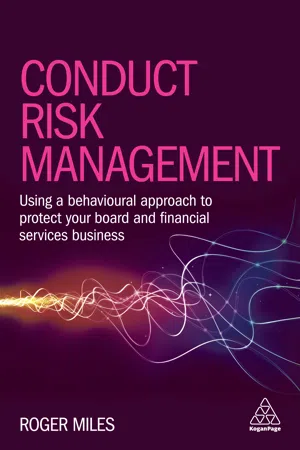
Conduct Risk Management
Using a Behavioural Approach to Protect Your Board and Financial Services Business
- English
- ePUB (mobile friendly)
- Available on iOS & Android
Conduct Risk Management
Using a Behavioural Approach to Protect Your Board and Financial Services Business
About this book
Conduct risk is at the core of behavioural regulation, a new approach to regulating financial services, whose new agencies and public prosecutors have spread rapidly across the world. Its prosecutors intervene assertively to challenge financial service providers to show clear evidence of a new customer-centric approach, which understands and responds to the hidden drivers of customer behaviour. They use their unprecedented powers to levy very large fines and even to imprison wrongdoers - often for not taking precautions rather than for any active wrongdoing. Conduct Risk Management is a tool for recognizing, acting on, and predicting conduct risk impacts in regulated business. Conduct Risk Management sees beyond econometric and other 'box-ticking' traditions of risk management. Whilst protecting senior managers, it helps all staff to make positive use of conduct risk to promote behaviour the regulator will accept as 'good', as good behaviour is good business. The new conduct regulations personally affect every manager in financial services, and their suppliers, with new regulations making senior managers liable to imprisonment for failures in organizational conduct. Conduct Risk Management sets out plainly what practitioners need to know to understand the regulator's intentions, to prove compliance, protect competitiveness and maintain licence to operate.
Frequently asked questions
- Essential is ideal for learners and professionals who enjoy exploring a wide range of subjects. Access the Essential Library with 800,000+ trusted titles and best-sellers across business, personal growth, and the humanities. Includes unlimited reading time and Standard Read Aloud voice.
- Complete: Perfect for advanced learners and researchers needing full, unrestricted access. Unlock 1.4M+ books across hundreds of subjects, including academic and specialized titles. The Complete Plan also includes advanced features like Premium Read Aloud and Research Assistant.
Please note we cannot support devices running on iOS 13 and Android 7 or earlier. Learn more about using the app.
Information
08
The ‘behavioural lens’, Part 1
Introduction: Normal and not-normal
- aggressive communications;
- unwanted attention;
- written material (exam topic, e-mail, etc) suggesting that a student may be unstable/mentally unwell;
- stalking (repeated attempts to impose unwanted communication or contact);
- threats of harm.
- Drinking a bit too much, losing a few clothes and singing raunchy songs might be just the kind of behaviour that makes one the life and soul of a bachelor party (or indeed, let’s be modern, bachelorette).
- Calling a competitor rude names, and even manhandling them some, is all part of the cut-and-thrust, if you’re playing various types of field sports.
- Yet none of those forms of behaviour is likely to play well at, for example, a job interview.
Table of contents
- Cover
- Praise for Conduct Risk Management
- Title Page
- Contents
- About the author
- Acknowledgements
- Dedication
- 01 TIME FOR A FRESH APPROACH
- 02 BEHAVIOURAL SCIENCE SETS REGULATORS THINKING…
- 03 THE ONSET OF FINANCIAL CONDUCT REGULATION
- 04 WHY REGULATORS HAD TO CHANGE DIRECTION
- 05 THE ROOTS OF MISCONDUCT
- 06 THE POLITICS OF PROSECUTION: CONDUCT RULES GO GLOBAL
- 07 ESTABLISHING WHAT YOUR ‘GOOD BEHAVIOUR LOOKS LIKE’
- 08 THE ‘BEHAVIOURAL LENS’, PART 1: WIDE VIEW
- 09 THE ‘BEHAVIOURAL LENS’, PART 2: STAYING AHEAD OF THE REGULATOR
- 10 LOOKING BACK, LOOKING AHEAD
- Glossary
- Recommended reading – with author’s comments
- Index
- Copyright